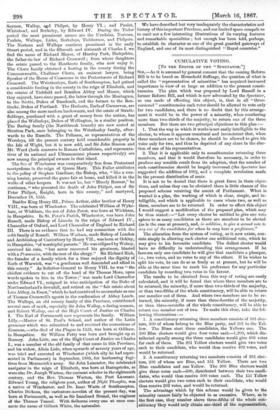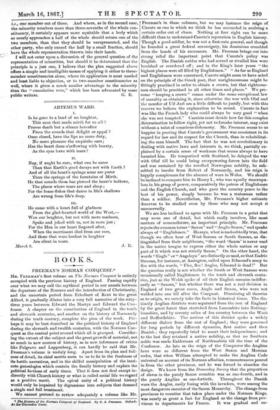CUMULATIVI. VOTING.
[To THE EDITOR OF THE "SPECTATOR."]
Si,—As it is assumed by general consent that the coming Reform Bill is to be based on Household Suffrage, the question of what is called the "representation of minorities" has acquired increased importance in view of so large an addition to the present consti- tuencies. The plan which was proposed by Lord Russell in a former Reform Bill, and which is now advocated by the Spectator, as one mode of effecting this object, is, that in all " three- cornered " constituencies each voter should be allowed to vote only for two candidates, and there is no doubt that by this arrange- ment it would be in the power of a minority, when numbering more than two-thirds of the majority, to return one of the three members. But there are two principal objections to this plan :— 1. That the way in which it works is not easily intelligible to the elector, to whom it appears unnatural and inconsistent that, when three members are to be chosen, he should be allowed to give his voice only for two, and thus be deprived of any share in the elec- tion of one of his representatives.
2. That it is applicable only to constituencies returning three members, and that it would therefore be necessary, in order to produce any sensible result from its adoption, that the number of such constituencies should be largely increased (the Spectator has suggested the addition of 100), and a complete revolution made in the present distribution of seats.
It is not to be denied that there is great force in these objec- tions, and unless they can be obviated there is little chance of the proposed scheme receiving the assent of Parliament. What is wanted is a plan, the working of which is clear, simple, and in- telligible, and which is applicable to cases where two, as well as three, members are to be returned. In order to effect this object I would suggest a modification of the proposed plan, which may be thus stated :—" Let every elector be entitled to give one vote apiece to as many candidates as there are members to be elected (as is the case at present), and, in addition, to give a second vote to any one of the candidates for whom he may have a preference."
The alteration from the system of voting, as it.now exists, con- sists simply in allowing each elector one additional vote, which he may give to his favourite candidate. The dullest elector would have no difficulty in understanding this arrangement. If he favours only one candidate he will give that candidate a plumper, i.e., two votes, and no votes to any of the others. If he wishes to split his vote, he can do so as freely as at present, but he will be able at the same time to mark his preference for any particular candidate by recording two votes in his favour.
The results to be obtained from this way of voting are easily calculated, and it will be found that where three members are to be returned, the minority, if more than two-thirds of the majority, or than two-fifths of the whole constituency, will be able to return one member out of three. And where two members are to be re- turned, the minority, if more than three-fourths of the majority, or than three-sevenths of the whole constituency, will be able to return one member out of two. To make this clear, take the fol- lowing illustrations :— 1. A constituency returning three members consists of 501 elec- tors, 300 of whom belong to the Blue party, and 201 to the Yel- low. The Blues start three candidates, the Yellows one. The 300 Blue electors would give four votes each-1,200, which dis- tributed equally among the three candidates would give 400 votes for each of them. The 201 Yellow electors would give two votes each to their candidate, who would thus receive 402 votes, and would be returned.
2. A constituency returning two members consists of 351 elec- tors, 200 of whom are Blue, and 151 Yellow. There are two Blue candidates and one Yellow. The 200 Blue electors would give three votes each-600, distributed between their two candi- dates, who would thus receive 300 votes each. The 151 Yellow electors would give two votes each to their candidate, who would thus receive 302 votes, and would be returned.
The advantage which by this scheme would be given to the minority cannot fairly be objected to as excessive. Where, as in the first case, they number above three-fifths of the whole con- stituency they would only obtain one-third of the representation,
i.e., one member out of three. And where, as in the second case, the minority numbers more than three-sevenths of the whole con- stituency, it certainly appears more equitable that a body which so nearly approaches a half of the whole should return one of the two members, than that they should be unrepresented, and the other party, who only exceed the half by a small fraction, should have the whole representation thrown into their hands.
will not enter upon a discussion of the general question of the representation of minorities, but should it be determined that the principle is a just one, I believe that the plan suggested above offers a simple and intelligible means of applying it either to three- member constituencies alone, where its application is most needed and least liable to objection, or to two-member constituencies as well, where it gives a much smaller advantage to the minority than the "cumulative vote," which has been advocated by some































 Previous page
Previous page